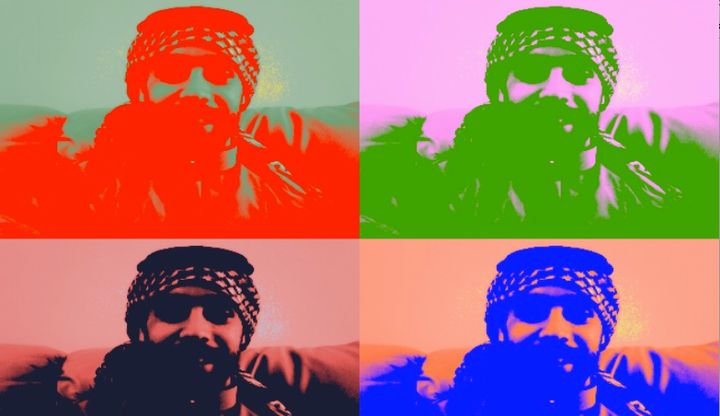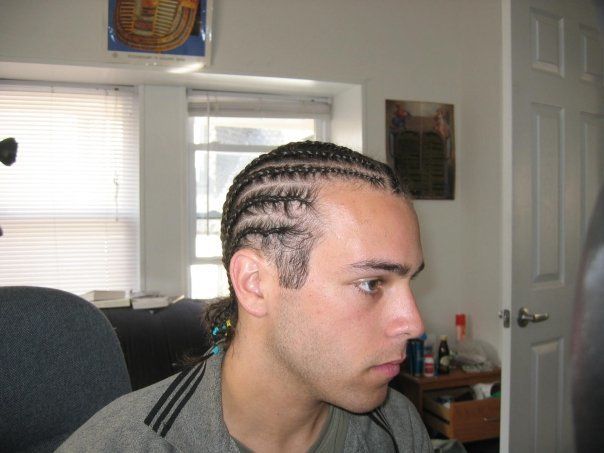
Photographic rendering by Apple’s Photo Booth software in 2010, while living in Doha, Qatar.
Ethnic ambiguity fosters exploration of Other cultures at the edges of the ‘white’ world
For much of modern history through the 1960’s, the “Mediterranean” race was a real thing. This “Caucasian” subgroup ranged from Southern Europe and North Africa into West Asia -- across the three great continents and monotheistic religions.
Proponents of the “master race” theory had a problem reconciling their worldview with the fact that so many ancient civilizations emerged from this fertile swath of the planet. “Melanochroi” or “dark whites” were those who often spoken Semitic or Hamitic languages.
In his 1901 book Mediterranean Race, Giuseppe Sergi said of this vast and diverse people cluster: “In its external characters is a brown human variety, neither white nor negroid, but pure in its elements.” From Egypt and Phoenicia to Greece and Rome, he argued that the top societies were all composed of Mediterranean stock: “the greatest race of the world.”
On the American continent, African-American writer W.E.B. DuBois also cited the achievements of Mediterranean peoples in debunking the ideas of white supremacists, who denied the equal merit of humans beyond Northwestern Europe.
While the term ceased to be used in contradistinction to the Nordic/Teutonic and Alpine “races,” naturally most people still understand what is meant by the “Mediterranean” look: olive skin, as well as relatively dark hair and eyes.
“Mediterraneanism” continues to describe the shared cultural characteristics of the Mediterranean basin, often in reference to restaurants serving its healthy and trendy cuisine. But no longer is the term used in contemporary politics to advocate Italian or French colonial expansion in the 21st century, or to provide an explicit right-wing counterpoint to notions of Aryan superiority.
Needless to say, the pseudoscience which also promoted eugenics and inspired fascism was ultimately discarded by the mainstream in favor of ideas based more on empirical data.

“Regional ancestry” results showing majority-Mediterranean ethnic mix as part of National Geographic’s Genographic Project.
Limits of white identity
In contemporary American racial discourse, the phrases “white people” and “people of color” can only go so far in explaining how we look, feel, and act.
The lines are often blurry between the white world and the rest. Practically speaking, the U.S. Census -- though in the process of overhauling its classification system -- has conventionally defined whiteness as having roots in the “original peoples of Europe, the Middle East, or North Africa.” So this corresponds broadly to the turn-of-the-century conception of “Caucasoid” and thus includes those previously viewed by racialists as “Mediterranean.”
But the White House actually proposed in October to add a Middle East and North Africa “MENA” category to the 2020 Census. Despite endless complexities and controversy, this could improve accuracy and representation -- though groups from the Northern Mediterranean, Asia Minor, and Caucasus seem still to be excluded.
There is obviously a continuum on which people would generally be considered more, or less, white. At the extremes, we usually know where people fit. But how about Greeks, Armenians, Georgians, and Lebanese? Persians, Israelis, Kurds, Cypriots? Sort of white but not so much? Definitely less than Swedes but somewhere in between the Swiss and the Saudis? Maybe it just depends on the individual?
In order to be more specific about my self-identification, I put down “Mediterranean” as my race in the 2010 Census.
I wasn’t always as conscientious about how I’m perceived. But after extensive travel and reporting in different parts of the globe, I find that “American” is often not a satisfactory answer for people who want to know where I’m “really from.” Of course I can always defer to my U.S. passport, but ethnic ambiguity allows me to pass as a wide range of -- largely Mediterranean -- nationalities.
In no way am I suggesting that “Mediterranean” people in America face poor treatment or widespread discrimination, but simply wish to articulate the specifics of identity politics in an era when this framework is en vogue. Yet it’s undeniable that people who look “Other-ish” are frequently stigmatized — even an Ivy League economist can seem scary while scribbling math equations on an airplane.
Undoubtedly, the recent election of Donald Trump to the U.S. presidency has forced many Americans to re-evaluate their relative levels of whiteness and Americanness -- from Hispanics and African-Americans to Arabs and Jews. With the latter groups in particular, old debates have resurfaced amidst the rise of the Alt-Right and resurgent white nationalism.

One of many algorithms showing ethnic admixture, the Jtest Model by Davidski, displays percentages of Ashkenazi, Eastern Mediterranean, and Middle Eastern as dominant in the author’s genetic makeup.
Are Jews white?
The answer historically was no, then yes, and now, “it’s complicated.” Jews, like many “diaspora” peoples, can often blend into their surroundings, whether Mediterranean or otherwise.
For most Sephardic and Mizrahi Jews of Iberian and Oriental origin, the MENA category always made more sense than white, so in the future perhaps there won’t be as much of an issue. For Ashkenazi Jews of recent European origin there’s more grey area, and often an easier time “passing” in an Anglo-American culture.
Jews have made it in America -- or have they? But with arguably the biggest wave of anti-Semitic agitation since the 1930's, many are questioning our collective place.
The spectrum of whiteness holds a multiplicity of options for identification, yet of course the formal government, employment, and educational categories don’t necessarily conform to the definitions in pop culture or stereotypes on the street.
I may be somewhat white but, depending on circumstances, embrace these labels too: Mediterranean, Other, Middle Eastern, “choose not to identify.” And perception depends on facial hair, gestures, and body language, in addition to head gear and clothes. All are part of the malleable identity equation in which one can code-switch to different ethnic identities.
With features that turn more swarthy in summer, I am often perceived as Italian or Greek. My family’s ancestry in the last 500 years spans across many countries in Western and Eastern Europe where Jews lived, but the genealogical and genetic evidence point to roots in the Levant, a long voyage around the Mediterranean, and some intermarrying along the way. Yet rarely would I be mistaken for a German or Ukrainian.
When I had braids (and a lot more hair) in Baltimore, I was asked if I was Puerto Rican or even part-black. With a full beard at college, I was called Taliban, jokingly. While traveling in Scandinavia, I was seen as South American.
In France, though I fancied myself as rather European for an American, I was accused of being a Moroccan Muslim and faced racist threats, with a man once asking if I had a prayer rug and threatening to call the cops because he thought my friend and I were suicide bombers. When I say it, “Américan” is often heard as “Marocain.”
Even in the Holy Land, I took advantage of my appearance as a U.S. citizen of generic Mediterranean appearance while visiting the Muslim side of the Tomb of the Patriarchs in Hebron — neither confirming nor denying Jewishness when asked by IDF soldiers, but just saying “I’m American,” and looking similar enough to the Turks and Palestinians in my group.
Working in Qatar, I was often treated as Lebanese or Syrian, receiving some cultural benefits to passing as a Levantine Arab, with the accent to match. A North African editor once called me “hard-headed, like an Arab.” Was that a half-compliment? Later at an Iran-Iraq soccer game in Doha, security personnel let me pass with my Persian friend to the Iranian fan side after I pretended to be from Iran.
Even in New York, I've been told to “go back to where you came from” by angry Trump supporters. Across the five boroughs, Yemeni shopkeepers and West African cabbies often assume I’m Levantine.

Smoking a water pipe, at a social gathering of locals and expatriates in Tel Aviv, Israel, in 2007.
Functional chameleon tendencies
Phenotype doesn’t account for everything, and a lot of my personal experience is a function of choice. As a journalist, it helps to communicate linguistic and cultural nuances, so chameleon tendencies have tremendous professional usefulness.
But there have been phases in which I rejected the accoutrements of uber-educated bourgeois society for earnest if quixotic attempts at incorporating aspects of the Other's identity. Perhaps I’m not fulfilled by the banalities of normal identity socialization, or am motivated by some odd combination of adventurousness, curiosity, and vanity.
The excitement of socio-cultural experimentation has driven my occasional, not-so-radical effort at assimilating and appropriating certain subaltern styles that are generally shunned by the mainstream: corn rows and Arabesque attire.
Maybe this is costume play with a little power politics, subverting cultural hegemony -- as two of the West’s biggest fears are rebellious Blacks and Arabs. At the same time, the hip-hop and Middle Eastern cultures that I’ve navigated are also legitimately part and parcel of the cosmopolitan urban settings in which I’ve resided, and are now internalized components of myself.
Identity is flexible and constantly evolving. Having grown up at a prep school dominated by WASP attire and norms, I often felt that I was in disguise there. The times when I took on attributes of Other cultures might have been attempts at resistance to that acculturation, on the path to a more balanced self-identity.
Of course I realize that in some settings I'm considered very white, but barely white elsewhere. I'm born into an affluent suburban family and fortunate to have received top-notch educational opportunities. Nonetheless, though I may be a privileged American, I mostly don't identify with the racial majority.
I’m not demanding redress, but merely stating my subjective experiences. And perhaps the era in which I needed to “pass” as preppy or “reverse-pass” as an official minority is in the youthful past. I recognize that I belong right here in the middle.

One of five times with corn rows, in 2005, at West Philadelphia residence during senior year of college.
Revisiting the Dolezal phenomenon
So if President Obama tells us racial identity is both socially constructed and biologically based, then why can’t we agree to tolerate “transracial” people like the infamous Rachel Dolezal?
Having been labeled guilty of expropriating and essentializing black identity, Dolezal’s new book “In Full Color” is set to be released during the first 100 days of Trump’s administration.
Maybe the book will reveal that Dolezal knows who she is after all. Will she refer to her blackness as genuine, literal, indisputable, or as symbolic, instrumental, ambivalent?
The new era will likely not be so kind to people confused about how to conform to conventional categories. Despite their affinity for free choice when it comes to education and health care, America’s ruling conservatives probably don’t care much for market solutions for racial, ethnic, or cultural identification. While libertarians may accept the possibility of fluid, overlapping categories, it’s doubtful that a theory of flexible identity would pass muster under Trumpism.
Dolezal is undoubtedly eccentric, but if she really believes in the cause and is sincere about contributing to the black community's efforts to right historic wrongs, what's the problem? How could anyone be duped into thinking she had four grandparents of African origin? Regardless, it is dubious to propagate public lies about one’s heritage.
Race is real and race is created. Race is in the eye of the beholder and the beholden. Race is right and race is wrong. Race changes and race stays the same. The same logic holds for the infinite and amazing wealth of ethnic groups on this green earth.
As I see it, there’s no point denying who we are. Let’s celebrate our uniqueness, borrow from other cultures when sincere, and always be comfortable -- yet not too proud -- of our peoplehood. Try on different hats, but always know at the end of the day which ones are ours.
